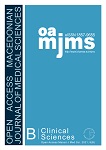Deferasirox Effect on Serum Ferritin in Iraq Patients with Hemoglobinopathies: A Single Center Experience
DOI:
https://doi.org/10.3889/oamjms.2021.5687Keywords:
Iron overload, Chelating agents, Thalassemia, DeferasiroxAbstract
BACKGROUND: The introduction of deferasirox as an oral iron chelator for hemoglobinopathies has been hailed by many as an important milestone in the management of iron overload in the latter disorders.
AIM: The objectives of the study were to evaluate the effectiveness of deferasirox in patients with hemoglobinopathies and to assess predictors of response.
METHODS: In this cross-sectional study, 160 patients diagnosed with hemoglobinopathies were included retrospectively from Jin hematology and oncology center in Duhok city, Iraqi Kurdistan. The Jin center offers patients with hemoglobinopathies clinical advice, examination, follow-up, treatment, and blood transfusions.
RESULTS: The median age of enrolled patients was 12 years (range 3–34 years), and included 86 females and 74 males. All patients were on deferasirox with a compliance rate of 77.5%. Furthermore, 32.3% were on concomitant deferoxamine at their last follow-up. After a median follow-up of 2.1 years (range 1–4 years), there was a mean reduction of serum ferritin level of −478.7 overall and −821.1 ng/ml in complaint patients (both being significant at p of 0.042 and 0.001, respectively). Univariate analysis revealed that older age at enrollment, and older age at starting therapy, and initial serum ferritin (>3000 ng/ml) were all significantly associated with more mean reduction in serum ferritin; while only the latter remained so by multivariate analysis (p = 0.04).
CONCLUSIONS: Deferasirox was found to be effective in reducing the level of serum ferritin among this cohort of hemoglobinopathy patients, to a degree comparable to that reported in other studies worldwide. Furthermore, there were significant associations between the reduction of serum ferritin level and age, age at starting treatment, drug compliance, and the initial serum ferritin levels.
Downloads
Metrics
Plum Analytics Artifact Widget Block
References
Kohne E. Hemoglobinopathies: Clinical manifestations, diagnosis, and treatment. Dtsch Arztebl Int. 2011;108(31-32):532-40. PMid:21886666
Hoffbrand AV, Taher A, Cappellini MD. How I treat transfusional iron overload. Blood. 2012;120(18):3657-69. https://doi.org/10.1182/blood-2012-05-370098 PMid:22919029
Breuer W, Hershko C, Cabantchik ZI. The importance of non-transferrin bound iron in disorders of iron metabolism. Transfus Sci. 2000;23(3):185-92. https://doi.org/10.1016/s0955-3886(00)00087-4 PMid:11099894
Saliba AN, Harb AR, Taher AT. Iron chelation therapy in transfusion-dependent thalassemia patients: Current strategies and future directions. J Blood Med. 2015;6:197-209. https://doi.org/10.2147/jbm.s72463 PMid:26124688
Cappellini MD, Porter J, El-Beshlawy A, Li CK, Seymour JF, Elalfy M, et al. Tailoring iron chelation by iron intake and serum ferritin: The prospective EPIC study of deferasirox in 1744 patients with transfusion-dependent anemias. Haematologica. 2010;95(4):557-66. https://doi.org/10.3324/haematol.2009.014696 PMid:19951979
Moukalled NM, Bou-Fakhredin R, Taher AT. Deferasirox: Over a decade of experience in thalassemia. Mediterr J Hematol Infect Dis. 2018;10(1):e2018066. https://doi.org/10.4084/mjhid.2018.066 PMid:30416698
Abdul-Hassan BA, Hassan MK, Jaber RZ. Deferasirox in chelation naïve children with transfusional iron overload in Basra, Iraq: A two-year single center study. Iran J Blood Cancer. 2019;11(4):115-22.
Mohsin AM, Hassan MK. A 3-year study of deferasirox therapy in sickle cell disease patients in Basra, Southern Iraq. Niger J Clin Pract. 2018;21(6):735-42. https://doi.org/10.4103/njcp.njcp_162_17 PMid:29888721
Cappellini MD, Zanaboni L. Efficacy and safety of deferasirox. Transfusion iron chelation therapy, US hematology. Touch Brief. 2009;107(9):68-73.
Cabantchik ZI, Breuer W, Zanninelli G, Cianciulli P. LPI-labile plasma iron in iron overload. Best Pract Res Clin Haematol. 2005;18(2):277-87. https://doi.org/10.1016/j.beha.2004.10.003 PMid:15737890
Daar S, Taher A, Pathare A. Deferasirox (Exjade, ICL670) provides 24 hour protection from labile plasma iron (LPI), in iron overloaded β-thalassaemia patients previously chelated with mono- or combination therapy. Haematologica. 2006;91(Suppl 1):31. https://doi.org/10.1182/blood.v108.11.1773.1773
Daar S, Pathare A, Nick H, Kriemler-Krahn U, Hmissi A, Habr D, et al. Reduction in labile plasma iron during treatment with deferasirox, a once-daily oral iron chelator, in heavily iron-overloaded patients with beta-thalassaemia. Eur J Haematol. 2009;82(6):454-7. https://doi.org/10.1111/j.1600-0609.2008.01204.x PMid:19191863
Taher A, El-Beshlawy A, Elalfy MS, Al Zir K, Daar S, Habr D, et al. Efficacy and safety of deferasirox, an oral iron chelator, in heavily iron-overloaded patients with beta-thalassaemia: The ESCALATOR study. Eur J Haematol. 2009;82(6):458-65. https://doi.org/10.1111/j.1600-0609.2009.01228.x PMid:19187278
Taher A, Elalfy MS, Al Zir K, Daar S, Al Jefri A, Habr D, et al. Importance of optimal dosing ≥ 30 mg/kg/d during deferasirox treatment: 2.7-yr follow-up from the ESCALATOR study in patients with β-thalassaemia. Eur J Haematol. 2011;87(4):355-65. https://doi.org/10.1111/j.1600-0609.2011.01662.x PMid:21668502
Pennell DJ, Porter JB, Cappellini MD, Chan LL, El-Beshlawy A, Aydinok Y, et al. Deferasirox for up to 3 years leads to continued improvement of myocardial T2* in patients with β-thalassemia major. Haematologica. 2012;97(6):842-8. https://doi.org/10.3324/haematol.2011.049957 PMid:22271905
Cappellini MD, Bejaoui M, Agaoglu L, Canatan D, Capra M, Cohen A, et al. Iron chelation with deferasirox in adult and pediatric patients with thalassemia major: Efficacy and safety during 5 years’ follow-up. Blood. 2011;118(4):884-93. https://doi.org/10.1182/blood-2011-09-377929 PMid:21628399
Porter JB, Elalfy MS, Taher AT, Aydinok Y, Chan LL, Lee SH, et al. Efficacy and safety of deferasirox at low and high iron burdens: Results from the EPIC magnetic resonance imaging substudy. Ann Hematol. 2013;92(2):211-9. https://doi.org/10.1007/s00277-012-1588-x PMid:23086508
Cohen AR, Glimm E, Porter JB. Effect of transfusional iron intake on response to chelation therapy in beta-thalassemia major. Blood. 2008;111(2):583-7. https://doi.org/10.1182/blood-2007-08-109306 PMid:17951527
Antmen B, Karakaş Z, Yeşilipek MA, Küpesiz OA, Şaşmaz İ, Uygun V, et al. Deferasirox in children with transfusion-dependent thalassemia or sickle cell anemia: A large cohort real-life experience from Turkey (REACH-THEM). Eur J Haematol. 2018;102(2):123-30. https://doi.org/10.4084/mjhid.2014.025 PMid:30300449
Soliman A, Yassin M, Al Yafei F, Al-Naimi L, Almarri N, Sabt A, et al. Longitudinal study on liver functions in patients with thalassemia major before and after deferasirox (DFX) therapy. Mediterr J Hematol Infect Dis. 2014;6(1):e2014025. https://doi.org/10.4084/mjhid.2014.025 PMid:24803998
Ejaz MS, Baloch S, Arif F. Efficacy and adverse effects of oral chelating therapy (deferasirox) in multi-transfused Pakistani children with β-thalassemia major. Pak J Med Sci. 2015;31(3):621-5. https://doi.org/10.12669/pjms.313.6972 PMid:26150856
Downloads
Published
How to Cite
Issue
Section
Categories
License
Copyright (c) 2021 Khalaf Hussein Hasan, Aspazija Sofijanova, Luma Hassan, Nasir Al-Allawi (Author)

This work is licensed under a Creative Commons Attribution-NonCommercial 4.0 International License.
http://creativecommons.org/licenses/by-nc/4.0








